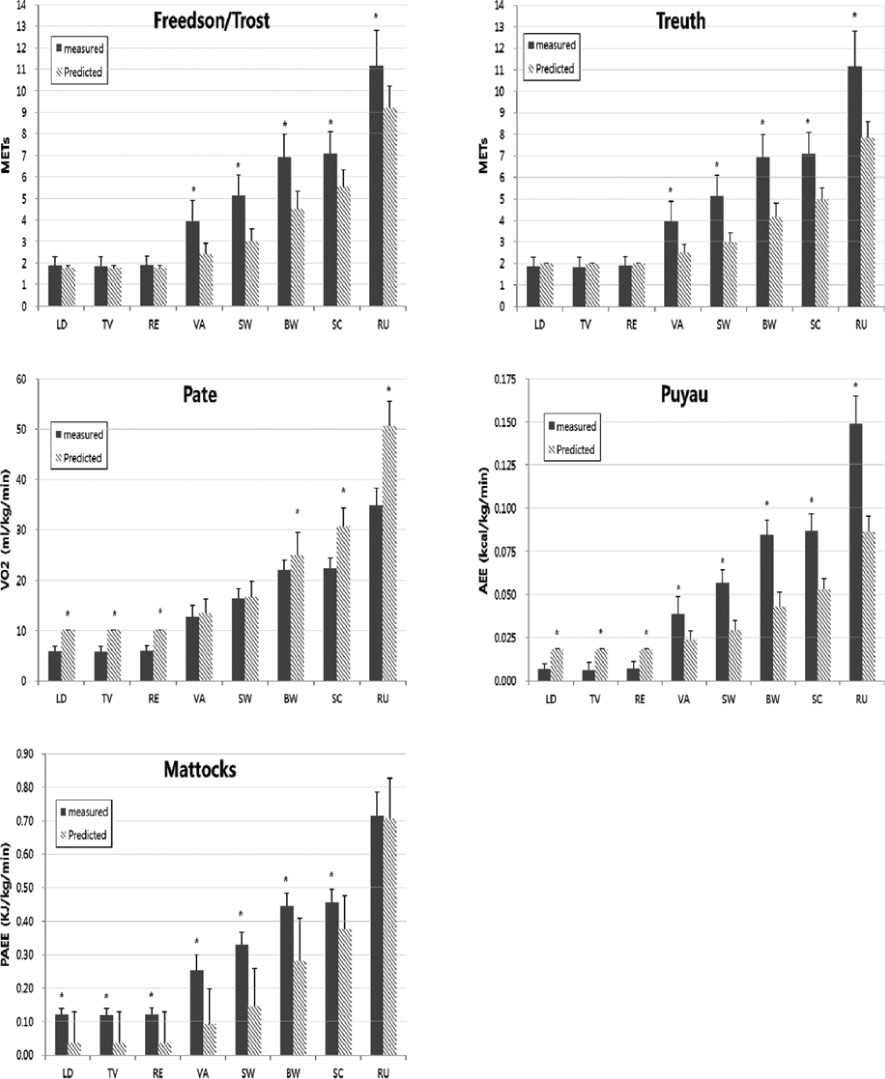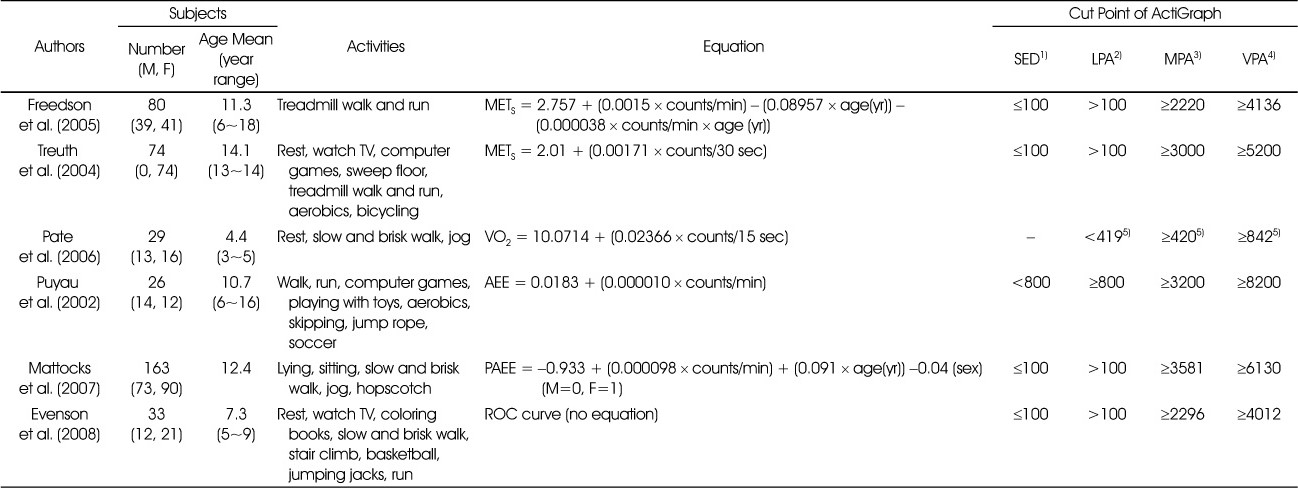References
1. American college of sports medicine. American dietetic association. Dietitians of Canada. Nutrition and athletic performance. Med Sci Sports Exerc 2000;32(12):2130–2145.
2. Ahn NY, Kim KJ. Effects of health education for the nutrient intakes and eating habits in youth athletes. J Coaching Dev 2011;13(1):277–282.
3. Loucks AB. Energy balance and body composition in sports and exercise. J Sports Sci 2004;22(1):1–14.
4. Kim EK, Kim GS, Park JS. Comparison of activity factor, predicted resting metabolic rate, and intakes of energy and nutrients between athletic and non-athletic high school students. J Korean Diet Assoc 2009;15(1):52–68.
5. Rowlands AV, Thomas PWM, Eston RG, Topping R. Validation of the RT3 triaxial accelerometer for the assessment of physical activity. Med Sci Sports Exerc 2004;36(3):518–524.
6. Boyd LJ, Ball K, Aughey RJ. The reliability of MinimaxX accelerometers for measuring physical activity in Australian football. Int J Sports Physiol Perform 2011;6(3):311–321.
7. Trost SG, Way R, Okely AD. Predictive validity of three ActiGraph energy expenditure equations for children. Med Sci Sports Exerc 2006;38(2):380–387.
8. Trost SG, Loprinzi PD, Moore R, Pfeiffer KA. Comparison of accelerometer cut points for predicting activity intensity in youth. Med Sci Sports Exerc 2011;43(7):1360–1368.
9. Kim DY. Reliability and validity of the Korean version of the multimedia activity recall for children and adolescents [dissertation] Graduate School of Korea National Sport University; 2010.
10. Yu JH, Lee SM. The effects of regular resistive exercise on cardiopulmonary ability and cerebral blood flow velocity. J Korean Soc Phys Med 2010;5(2):255–264.
11. Wixted AJ, Thiel DV, Hahn AG, Gore CJ, Pyne DB, James DA. Measurement of energy expenditure in elite athletes using MEMS-based triaxial accelerometers. IEEE Sens J 2007;7(4):481–488.
12. Kim JH, Son HR, Choi JS, Kim EK. Energy expenditure measurement of various physical activity and correlation analysis of body weight and energy expenditure in elementary school children. J Nutr Health 2015;48(2):180–191.
13. Treuth MS, Schmitz K, Catellier DJ, McMurray RG, Murray DM, Almeida MJ. Defining accelerometer thresholds for activity intensities in adolescent girls. Med Sci Sports Exerc 2004;36(7):1259–1266.
14. Kim YJ, Wang CS, Kim EK. Measurement of energy expenditure through treadmill-based walking and self-selected hallway walking of college students: using indirect calorimeter and accelerometer. Korean J Community Nutr 2016;21(6):520–532.
15. Mattocks C, Leary S, Ness A, Deere K, Saunders J, Tilling K. Calibration of an accelerometer during free-living activities in children. Int J Pediatr Obes 2007;2(4):218–226.
16. Freedson P, Pober D, Janz KF. Calibration of accelerometer output for children. Med Sci Sports Exerc 2005;3711 Suppl. :S523–S530.
17. Pate RR, Almeida MJ, McIver KL, Pfeiffer KA, Dowda M. Validation and calibration of an accelerometer in preschool children. Obesity (Silver Spring) 2006;14(11):2000–2006.
18. Puyau MR, Adolph AL, Vohra FA, Butte NF. Validation and calibration of physical activity monitors in children. Obes Res 2002;10(3):150–157.
19. Evenson KR, Catellier D, Gill K, Ondrak K, McMurray RG. Calibration of two objective measures of physical activity for children. J Sports Sci 2008;26(14):1557–1565.
20. Strath SJ, Bassett Jr DR, Thompson DL, Swartz AM. Simultaneous heart rate-motion sensor technique to estimate energy expenditure. Med Sci Sports Exerc 2001;33(12):2118–2123.
21. Rosenberger ME, Haskell WL, Albinali F, Mota S, Nawyn J, Intille S. Estimating activity and sedentary behavior from an accelerometer on the hip or wrist. Med Sci Sports Exerc 2013;45(5):964–975.
22. Schofield WN. Predicting basal metabolic rate, new standards and review of previous work. Hum Nutr Clin Nutr 1985;39(1):5–41.
23. Pulsford RM, Cortina-Borja M, Rich C, Kinnafick FE, Dezateux C, Griffiths LJ. Actigraph accelerometer-defined boundaries for sedentary behaviour and physical activity intensities in 7 year old children. PLoS ONE 2011;6(8)e21822.
24. Metz CE. Basic principles of ROC analysis. Semin Nucl Med 1978;8(4):283–298.
25. Obuchowski NA. Receiver operating characteristic curves and their use in radiology. Radiology 2003;229(1):3–8.
26. Landis JR, Koch GG. The measurement of observer agreement for categorical data. Biometrics 1977;33(1):159–174.
27. Energy and protein requirements. Report of a joint FAO/WHO/UNU expert consultation. World Health Organ Tech Rep Ser 1985;724:1–206.
28. Ridley K, Olds TS. Assigning energy costs to activities in children: a review and synthesis. Med Sci Sports Exerc 2008;40(8):1439–1446.
29. Weyer C, Snitker S, Rising R, Bogardus C, Ravussin E. Determinants of energy expenditure and fuel utilization in man: effects of body composition, age, sex, ethnicity and glucose tolerance in 916 subjects. Int J Obes Relat Metab Disord 1999;23(7):715–722.
30. Bosy-Westphal A, Kossel E, Goele K, Later W, Hitze B, Settler U. Contribution of individual organ mass loss to weight loss-associated decline in resting energy expenditure. Am J Clin Nutr 2009;90(4):993–1001.
31. Lee MH. Accuracy of accelerometer cut-points for estimating physical activity intensity for children. Korean J Meas Eval Phys Educ Sports Sci 2014;16(2):13–26.
32. Sirard JR, Trost SG, Pfeiffer KA, Dowda M, Pate RR. Calibration and evaluation of an objective measure of physical activity in preschool children. J Phys Act Health 2005;2(3):345–357.
33. Crouter SE, Horton M, Bassett DR. Validity of ActiGraph child-specific equations during various physical activities. Med Sci Sports Exerc 2013;45(7):1403–1409.
34. Pfeiffer KA, Schmitz KH, McMurray RG, Treuth MS, Murray DM, Pate RR. Variability in energy expenditure of selected activities in adolescent girls. Am J Prev Med 2006;31:328–331.







